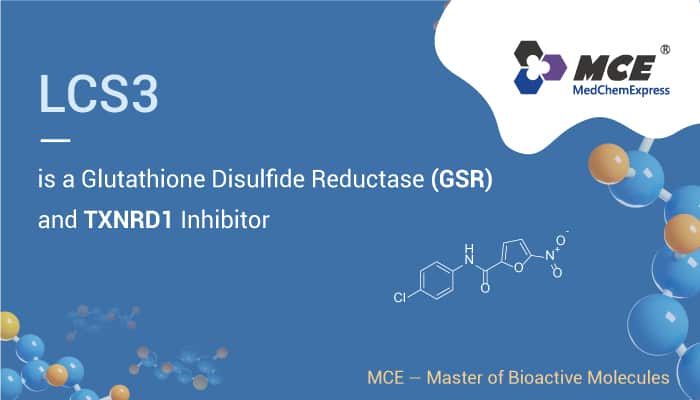Glutathione Disulfide Reductase (GSR), also known as glutathione reductase (GR), catalyzes the reduction of glutathione disulfide (GSSG) to glutathione (GSH) in the presence of NADPH and flavin adenine dinucleotide (FAD). GSH acts as a scavenger of reactive oxygen species (ROS) such as free radicals, peroxides, lipid peroxides and heavy metals to maintain normal cellular function and resist oxidative stress. In cells, GSH is usually present in the reduced (GSH) and oxidized (GSSG) states. The ratio of reduced to oxidized glutathione is often used as an indicator of oxidative stress in cells. Thioredoxin reductase 1 (TXNRD1) is predominantly located in the cytoplasmic lysis and contains a catalytically essential selenocysteine residue at its C-terminal active site. Moreover, TXNRD1 catalyzes the reduction of thioredoxin (TRX) to its dithiol-containing form and regulates cellular redox reactions for oxidative damage defense.
LCS3 is a synergistic inhibitor of GSR and TXNRD1.

GSR and TXNRD1 are essential for cell growth and survival and have some synergistic effects. For example, GSH non-enzymatic can reduce glutaredoxin-2 (GLRX2) and TXNRD can also reduce it with no enough GSH. Meanwhile, glutaredoxin-1 (GLRX1) can rescue the loss of TXNRD1 by catalyzing the transfer of electrons from GSH to TRX. Among these, TXNRD1 is overexpressed in a variety of malignant cells. Also, there is increasing interest in potential targets for TXNRD1-based cancer therapy.
LCS3 can non-competitively inhibit disulfide bond reductase activity with the IC50 values of 3.3 µM and 3.8 µM for the mediated GSR and TXNRD1 inhibitory activities, respectively. In addition, LCS3 (3 µM, 96 h) can induce activation of ROS and NRF2 pathways in sensitive lung adenocarcinoma (LUAD) cells. NRF2 is a major regulator of redox homeostasis and response to oxidative stress. Besides, it further selectively kills lung adenocarcinoma (LUAD) cell lines through an oxidative stress-induced apoptosis mechanism.
In conclusion, LCS3 is a potent and reversible inhibitor of GSR and TXNRD1 with anti-tumor activity.
References:
[1] Cell Rep. 2022 Feb 8;38(6):110343.
[2] J Biol Chem. 2012 Nov 2;287(45):38210-9.